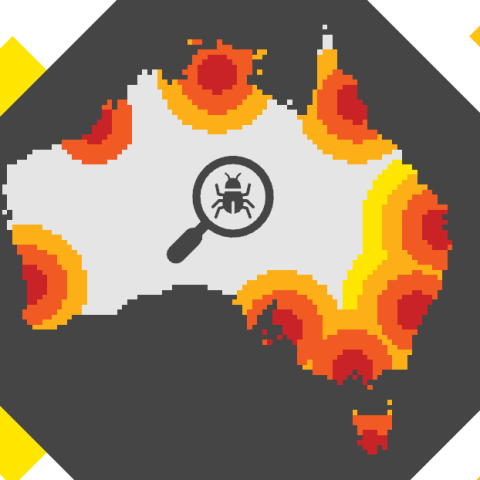Changing climate and increasing globalisation of human movement and trade have dramatically increased the exposure of Australia to new pests and diseases that can have devastating economic, environmental, and social impacts.
In response to this urgent challenge, Biosecurity Commons was launched in 2023 to empower researchers, policymakers, and decision-makers to estimate and manage biosecurity risks more effectively.
Now, a new round of co-investment from the ARDC and partners spanning academia, industry and government is launching Biosecurity Commons into its second phase. Led by the Centre of Excellence for Biosecurity Risk Analysis (CEBRA) at The University of Melbourne, Biosecurity Commons is now working with stakeholders and end-users across government, agriculture and forestry to build real-world use cases while also identifying and implementing required platform refinements.
Stage 2 is supported by the ARDC’s Planet Research Data Commons through the Modelling, Analytics and Decision Support Infrastructure (MADSI) focus area. MADSI is building national infrastructure that provides easy access to scientific models, analysis and decision-support tools, and platforms.
Dr James Camac, Senior Research Fellow, Chief Investigator of CEBRA and Project Manager of Biosecurity Commons said: “The need for a risk analytics platform like Biosecurity Commons has never been so important. Not only does it provide access to reproducible cutting-edge risk analytics for informing decision-making, it also provides tangible benefits in increasing collaboration across industry and governments and building analytical capacity in nearby neighbouring countries. This combination will create a more coordinated, efficient and effective biosecurity system.”
Hamish Holewa, Director, Planet Research Data Commons, ARDC, said: “Introduction, establishment and spread of new pests and diseases is a growing risk for Australia, with biosecurity recognised as a national science priority. We’re pleased to continue to partner across sectors to support research and research translation that improves Australia’s capacity to understand and manage ever-increasing biosecurity risks.”
Bridging the Gap with Biosecurity Commons
Biosecurity Commons addresses a critical gap in the fight against emerging threats. While significant investments have been made in standardised biosecurity databases and surveillance technologies, there remains a need for an accessible risk analytics platform. Currently, cutting-edge risk analytics tools are developed by academics for academics, leaving policymakers and practitioners without the necessary resources.
Researchers and decision makers in the government, university, environment and agriculture sectors benefit from the project’s core features:
1. Collaboration at Its Core
- Biosecurity Commons fosters collaboration between jurisdictions and researchers. The platform enables co-development of publishable biosecurity risk analyses.
- The Steering Committee ensures diverse expertise from different biosecurity sectors.
2. Cloud-Based Modelling Solutions
- Decision-makers and researchers now have access to cloud-based modelling solutions. These evidence-based tools empower rapid responses to current and emerging biosecurity threats.
3. Secure Analysis Environment
- A secure, permissioned online analysis environment promotes collaboration across state jurisdictions and disciplines.
- Timely and effective responses to biosecurity events are facilitated.
Partnership for Progress
Biosecurity Commons partnership spans academia, industry and government. It is led by the Centre of Excellence for Biosecurity Risk Analysis (CEBRA) at The University of Melbourne in partnership with Australian Research Data Commons (ARDC), Australian Government Department of Agriculture, Fisheries and Forestry (DAFF), Queensland Government Department of Agriculture and Fisheries (QDAF), AUSVEG, EcoCommons Australia, Australian Forest Products Association, Plant Health Australia, The University of the Sunshine Coast, Citrus Australia Ltd and Ausvet.
Biosecurity Commons is being expanded to:
- develop nationally consistent risk analytics for the Australian vegetable industry, that can be leveraged by all plant industries, through an AUSVEG partnership project with CEBRA
- move from a proof-of-concept phase to a trial and evaluation stage through a partnership with the Plant Protection and Environmental Biosecurity Division, supported by funding from the Australian Government Department of Agriculture, Forestry and Fisheries (DAFF)
- integrate wildlife camera trap and ecoacoustics data on invasive species through Planet Research Data Commons-supported projects WildObs and Open Ecoacoustics
- integrate modelling workflows to answer biosecurity policy questions to enhance rapid decision making, with a focus on Lumpy Skin Disease (a Food Security Data Challenges project).
Learn more about the next phase of Biosecurity Commons.
-Ends-
The ARDC is enabled by the National Collaborative Research Infrastructure Strategy (NCRIS) to support national digital research infrastructure for Australian researchers.
Photo: Dr James Camac. Credit: ARDC




